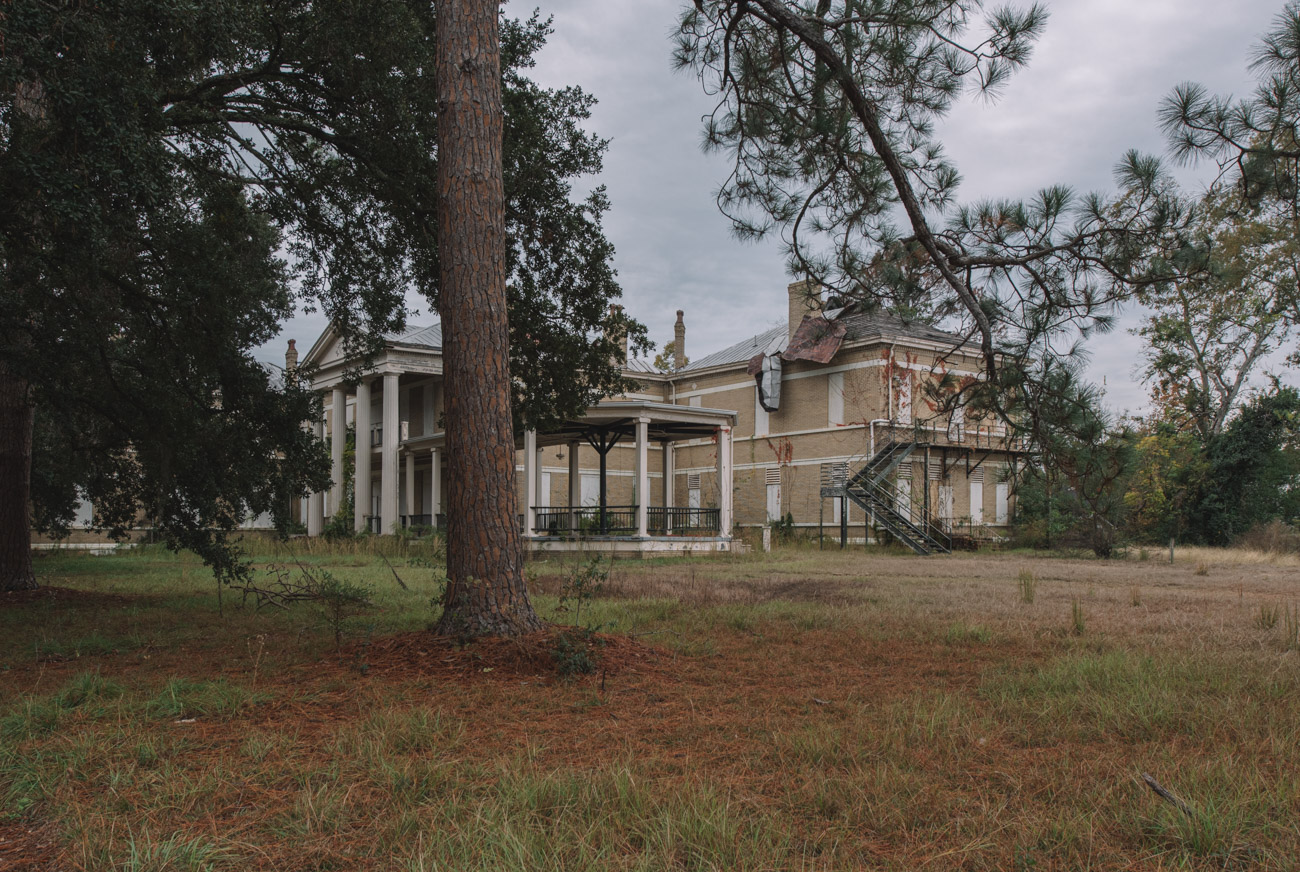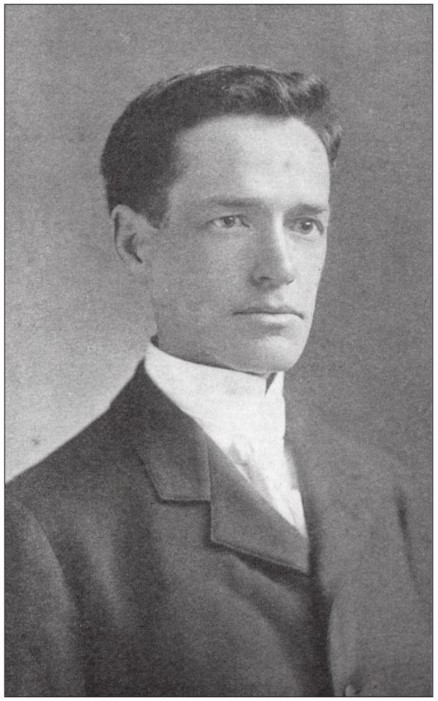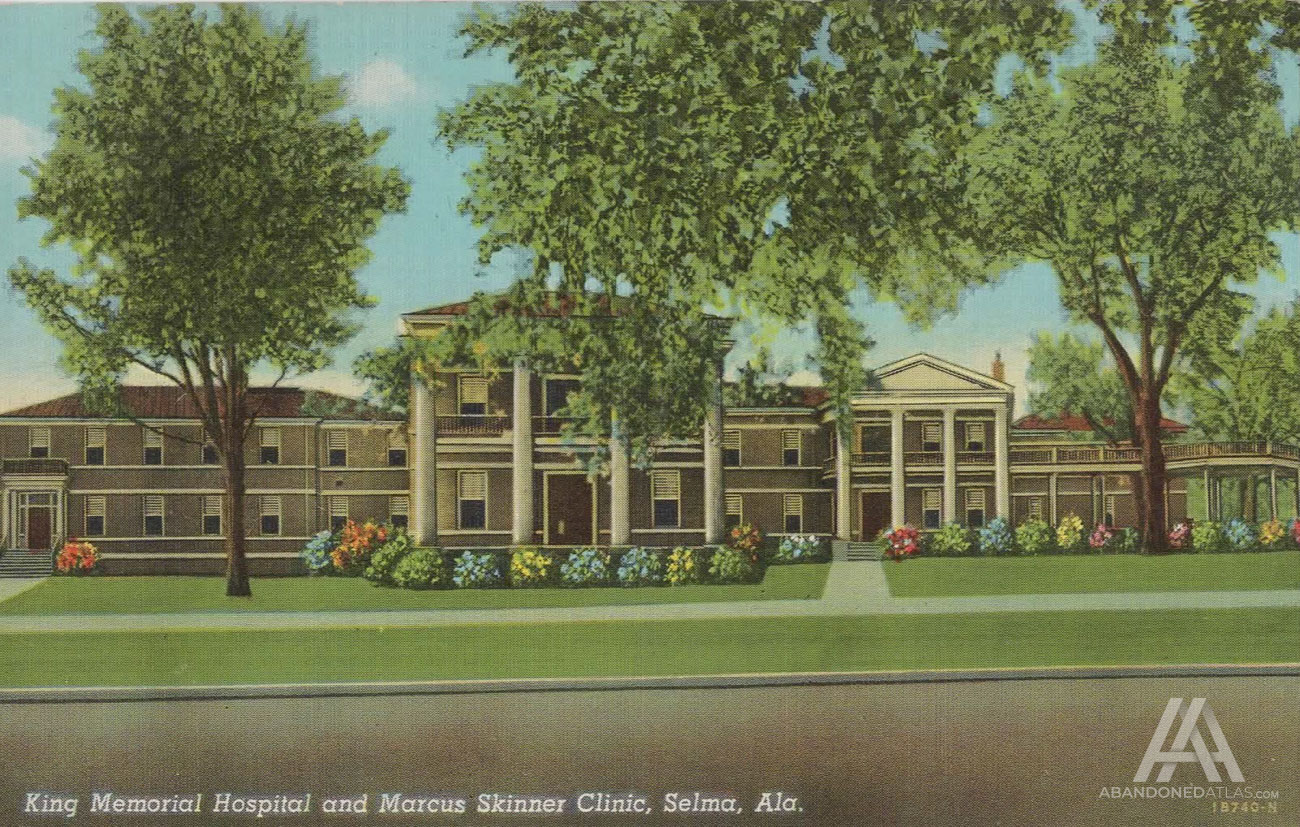| City/Town: • Selma |
| Location Class: • Medical |
| Built: • 1896 | Abandoned: • 2006 |
| Historic Designation: • National Register of Historic Places (1978) |
| Status: • Abandoned |
| Photojournalist: • David Bulit |
Table of Contents
Not far from Selma’s downtown district lies the remains of King Memorial Hospital, known more recently as Dunn Nursing Home. It is listed on the National Register of Historic Places as a contributing structure of the Old Town Historic District. Its history dates back to 1896 when it was first opened as King Sanitarium by local doctor Goldsby King. The hospital would later be purchased and gain national attention for housing the clinic of renowned orthopedic surgeon, Dr. Marcus Meyer Skinner.
Dr. Marcus Meyer Skinner
Dr. Marcus Meyer Skinner was born on February 29, 1892, in the small town of Furman, Alabama, the son of William Lamb and Rebecca Elizabeth Stone Skinner. He was taken to Selma when he was just six weeks old. Skinner attended the Dallas Academy until 1906 and the Selma Military Institute until 1908. He received his medical degree in 1912 at the University of Alabama Medical Department in Mobile. His postgraduate work included house surgeon at Mobile City Hospital, house officer at New York Hospital, and house surgeon at Boston Children’s Hospital.
While in Boston, Skinner met the Chief of Orthopedics at Boston Children’s Hospital, Dr. Robert Williamson Lovett. Dr. Lovett traveled throughout the northeast to assist with training on muscle re-education related to polio and opened the country’s second diagnosis-specific polio clinic in 1911. He would become considered the leading medical expert on polio during the disease’s early onset in the United States. It was also Dr. Lovett who diagnosed President Franklin D. Roosevelt with infantile paralysis in August 1921.
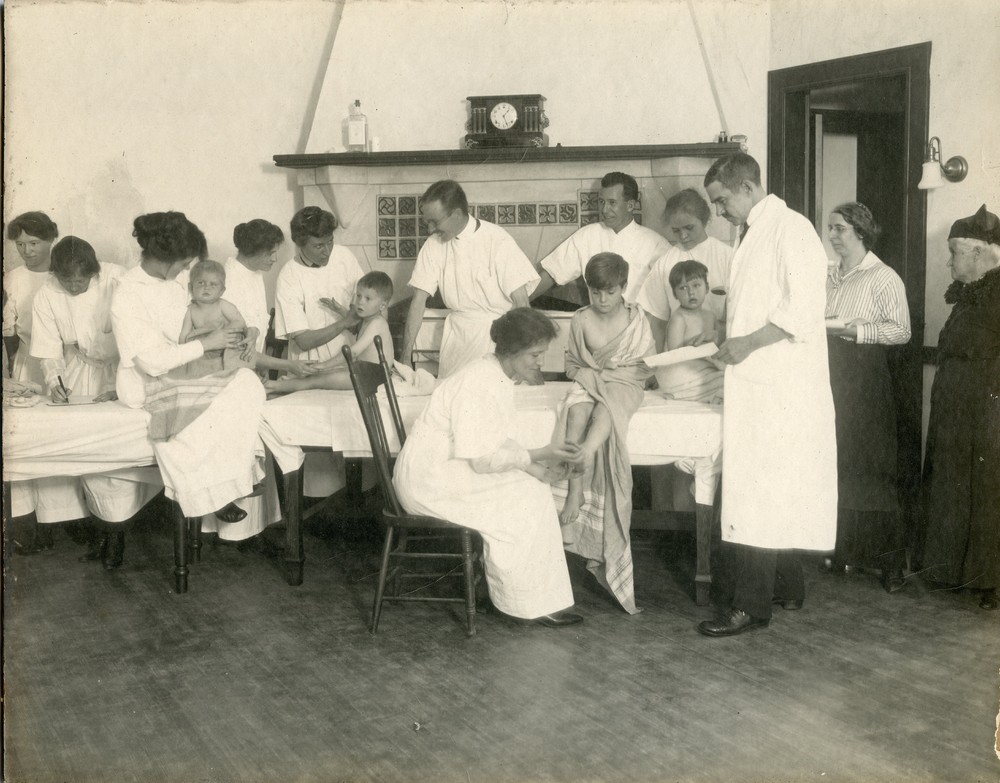
Dr. Lovett recommended Dr. Skinner to be the first assistant to Sir Robert Jones. He was a Welsh surgeon who many consider being the “father of orthopedic surgery.” He was also an early proponent of the use of radiography in orthopedics having used an X-ray to locate a bullet in a 12-year-old boy’s wrist on February 7, 1896, less than two months after the discovery of X-rays.
Dr. Skinner served as first assistant at the Royal Southern Hospital in Hoswell, England for two years until the outbreak of World War I. From 1915 through 1916, Dr. Skinner served with Sir Jones in the Medical Corps of the British Army in Leeds, Belfast, and France. After the war, Skinner continued working in England until 1919 when he moved back to Selma, Alabama. In 1921, Dr. Skinner purchased a private hospital in Selma after the death of its founder, Dr. Goldsby King.

Dr. Goldsby King
Goldsby King was born on April 29, 1860, the son of Edward Byrd and Elizabeth Ann Goldsby King, and the grandson of Dr. Thorton Boykin Goldsby. Goldsby was left an orphan in his teen years after the death of his father in 1866 and his mother in 1872. King received his academic training in the public schools of Selma before receiving his medical degree from the South Carolina Medical College in 1880.
After one year of working as a house surgeon and physician at the Charleston city hospital in South Carolina, he moved back to Selma where he was the city and county physician, 1883-84, and was a surgeon at the city hospital for some time. He also served as a member and secretary of the board of censors of the Dallas County Medical Society. In 1885, Dr. King continued his studies in Heidelberg, Germany, and did postgraduate study at John Hopkins Hospital in Baltimore, Massachusetts in 1889.
Dr. King married Annie Graham King in 1883. They had two daughters together, Julia and Annie Graham, and two sons who died in infancy.
King Sanitarium
Before 1896, the city of Selma never had a permanent hospital. Instead, a city hospital would be established during times of sporadic outbreaks of yellow fever. These hospitals were usually mismanaged and underfunded, and established in existing structures in need of maintenance. During Dr. Skinner’s time as the city physician, he made house calls which was found to be horribly inefficient. It was possible that due to these inefficient, monetary, and management issues that plagued the city hospitals of Selma that Dr. King decided to establish King Sanitarium, the city’s first private hospital.
The sanitarium started from an old southern home sitting back from the street amongst stately oak trees. The building was completely refurbished with new wallpaper, carpeting, and furniture which gave it an air of refinement that was pleasing and inviting. Eighteen patient rooms were outfitted with a neat iron bed, elegant rugs a table and lamp, and a call bell. The patients were tended to by Nurses who had experience working at Bryce Hospital in Tuscaloosa and lived in quarters adjoined to the building. The hospital also had a resident physician at all hours of the day.
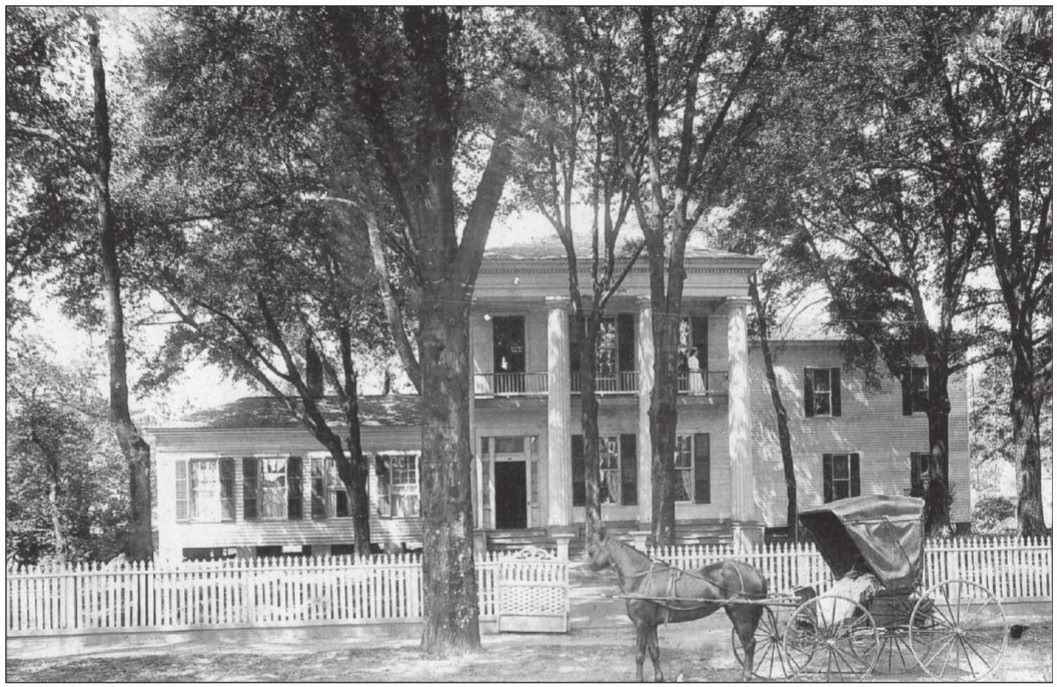
Patients and staff were supplied with fresh milk and butter from the hospital’s herd of Jersey cows, Mrs. King personally prepared most of the breads, jellies, and desserts. Meals were served on silver platters with flowers, fine china, and white linens.
The operating room was on the ground floor at the rear of the building. The operating table was hollow so it may be filled with hot water to keep the patient warm during surgery. Adjoining the operating room was a small room containing hundreds of different kinds of medical instruments Dr. King had purchased while in Europe.
Over time, the hospital grew to its current state. The hospital was recognized as one of the finest in the South. When questioned about its luxuries, King was quoted as saying, “Some men have their yachts. My hospital is my yacht and I prefer to spend my money that way.”
On April 5, 1920, Dr. Goldsby King died suddenly. Upon his death, Mrs. King decided to sell the hospital with the only caveat that King’s name shall be retained on the building. She used the proceeds from the building sale to establish Brazil, the Belgian Congo, and China, all named King Memorial Hospital.

King Memorial Hospital
Following King’s death, Dr. Marcus Skinner and a group of physicians purchased King Sanitarium in May 1920. Not long before King’s death, the hospital building was practically rebuilt with bricks and enlarged and had modern equipment installed. The hospital was renamed the Goldsby King Memorial Hospital as part of the purchase agreement. In May 1937, it was announced that a $50,000 addition known as the Marcus Skinner Clinic would be added to King Memorial Hospital.
Dr. Skinner administered and was chief surgeon of King Memorial Hospital and Marcus Skinner Clinic for 30 years. During that time, he perfected techniques in orthopedic surgery and was regarded as a pioneer for his treatment of crippled children. In 1926, he and several other doctors founded the Alabama Crippled Children’s Society. Dr. Skinner held membership in local, state, and national medical organizations, including the American College of Surgeons and the Dallas County Medical Society, which he served as a past president. He also wrote extensively on his surgical techniques for medical journals and conferences.
He retired from his position as chief surgeon and administrator of King Memorial Hospital in 1951. Dr. Marcus Meyer Skinner died on November 22, 1961. King Memorial Hospital closed in June 1953.
Dunn Rest Home
The former King Memorial Hospital was purchased by a group of investors who had formed the Dunn Rest Home Inc., in 1955. Charles E. Dunn, a practicing physical therapist was president and general of the corporation; Ed McBride, owner of the Tillman Drug Company, served as vice-president; Dunn’s wife, Ellen Burton Dunn, served as secretary-treasurer. The facility reopened in March 1956 as the Dunn Rest Home and operated until November 1983 when it was sold to Vari-Care Inc. Following the purchase, the facility was renovated along with the restoration of the gazebo. In December 1992, it was announced that the Dunn Nursing Home was purchased by a group of investors led by Charles Hise.
In February 2001, Dunn Nursing Home officials announced that a $5 million, 50,000-square-foot nursing facility was in development. The new nursing home would be known as Park Place Nursing and Rehabilitation Center and located at 100 Park Place, near Vaughan Regional Medical Center. Park Place opened nearly three years later on February 14, 2004, and the old Dunn Nursing Home was subsequently closed down.
Abandonment
In 2004, the old King Memorial Hospital was purchased by Circle of Love Outreach, a group founded by Pastor Gary Crum in 2002, with plans to turn it into a homeless shelter. The building was named Circle of Love and several renovations were completed, but it didn’t take long for the group to realize that there was a lot more work to be done. The building had old elevators that needed repairs and the building required a new roof.
The building didn’t host many tenants when Circle of Love owned it. Following Hurricane Katrina, the building opened up as a shelter for an estimated 40 families, but that only lasted for a short period. A short time later, the building was used to house about 15 Wallace Community College Selma students. Since then, the former hospital building has been vacant, the reason simply being that it wasn’t generating any income. The IRS seized the property in 2016 due to nonpayment of IRS taxes. There are no current plans for the building.

